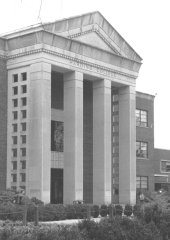
Harding Timeline
1924
—Harper College and Arkansas Christian College merge to form Harding University in Morrilton, Arkansas. With J.N. Armstrong as president, the college opens with 288 students.1928—Harding obtains accreditation from the Arkansas State Board of Education.
1934—Acquiring the properties of Galloway College for $75,000, Harding moves from Morrilton to Searcy and opens with 461 students.
1936—President Armstrong retires to serve as the dean of Bible and Dr. George Benson returns from China to serve as Harding’s second president.
1939—On Thanksgiving Day, Armstrong ceremoniously burns the mortgage in a fire on the front lawn. The campus has never been mortgaged since.
1941—President Benson speaks in Washington, D.C. to the U.S. House Ways and Means Committee. He and Harding become well known almost overnight for their campaign against the threat of Communism.

1944—Armstrong dies in August.
1947—Postwar enrollment jumps to 728.
1954—On March 14, Harding is approved for national accreditation by the North Central Association.
1962—The Graduate School campus in Memphis and the Searcy campus become racially integrated. Harding is the first private college in Arkansas to integrate.
1965—President George Benson retires and Dr. Clifton L. Ganus Jr. becomes the third president. Associate Women for Harding and the President’s Development Council are founded. Enrollment reaches 1,472, and the college begins a partnership with NASA, performing physical fitness research for astronauts.
1973—Christian Communications Program (now called School of Biblical Studies) is established in order to train ministers, missionaries and personal workers in evangelism.
1974—Harding’s 50th anniversary year. The School of Nursing is started.
1979—With five schools or colleges comprising its academic offerings, Harding College becomes Harding University.
1981—Enrollment tops 3,000 students and new facilities include Benson Auditorium, still the largest auditorium in the state, and the Mabee Business Building.
1984—Harding begins its international studies program and purchases a villa in Florence, Italy, to begin the HUF program.
1985—Wal-Mart founder begins Walton Scholarship Program for Central American students.
1987—Dr. Ganus retires from the university presidency and Dr. David Burks becomes Harding’s fourth president.
1990—Major renovations are undertaken on Armstrong Hall, Cathcart Hall, Graduate Hall, Kendall Hall and the library, which is rebuilt and renamed Brackett Library.
1994—The Jim Bill McInteer Bible and World Missions Center is built and the C.L. Kay Plaza is developed.
1996—Searcy Hall, apartment-style dormitory, and Harding Place retirement center are opened.
1997—Enrollment tops 4,000 and Rhodes Memorial Field House undergoes major renovations for intercollegiate basketball and volleyball play.
1998—Harding’s 75th anniversary year. The $6 million Reynolds Center for Music and Communication is completed and the Stevens Art Center is expanded to include new galleries and classrooms.